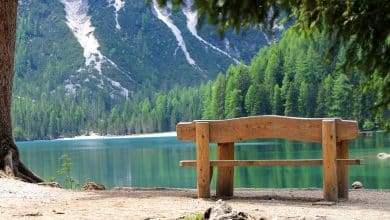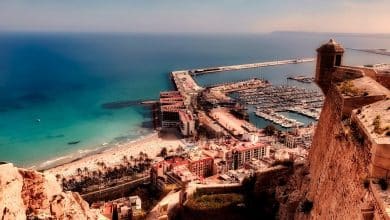Best 20 National Parks in Spain to Visit

Spain is known for its diverse landscapes, rich cultural heritage, and a wide variety of recreational activities. The country is home to many national parks, which offer visitors the opportunity to explore beautiful mountain ranges, rugged peaks, deep canyons, cascading waterfalls, wetlands, and subtropical forests. These parks are also home to a diverse array of flora and fauna, and many of them are recognized as UNESCO Biosphere Reserves for their ecological importance and sustainable management practices.
1- Teide National Park – Tenerife, Canary Islands
Teide National Park is the most visited National Park in Spain, located in the island of Tenerife, Canary Islands. It is home to the Teide volcano, which is the highest point in Spain and the third-highest volcano in the world measured from its base on the ocean floor. The park is also known for its unique and diverse landscapes, including lunar-like volcanic landscapes, lush subtropical forests, and beautiful beaches. The park also offers a variety of recreational activities such as hiking, rock climbing, and stargazing. The park has been designated as a UNESCO World Heritage Site and is a must-visit destination for nature and adventure enthusiasts.
2- Ordesa y Monte Perdido National Park – Huesca, Aragon
Ordesa y Monte Perdido National Park is located in the Pyrenees Mountains in the northeastern region of Aragon, Spain. The park is known for its stunning landscapes, including deep canyons, rugged peaks, and cascading waterfalls. The park’s main feature is Monte Perdido, which is the third-highest peak in the Pyrenees and a popular destination for hikers and mountaineers. The park is also home to a diverse array of flora and fauna, including the Pyrenean desman, a small aquatic mammal found only in the Pyrenees, and the bearded vulture, a rare bird of prey. The park also offers a variety of recreational activities such as hiking, rock climbing, and wildlife watching. It is also a UNESCO World Heritage Site.
3- Aigüestortes i Estany de Sant Maurici National Park – Catalonia
Aigüestortes i Estany de Sant Maurici National Park is located in the Pyrenees Mountains in the Catalonia region of Spain. The park is known for its beautiful glacial lakes and rivers, which are surrounded by lush vegetation and rugged peaks. The park’s main feature is the Estany de Sant Maurici, a glacial lake with crystal-clear waters. The park also offers a variety of recreational activities such as hiking, rock climbing, and wildlife watching. The park is also home to a diverse array of flora and fauna, including the Pyrenean chamois, a type of mountain goat, and the alpine ibex, a wild mountain goat. The park is also a UNESCO Biosphere Reserve, recognized for its natural beauty, ecological importance, and sustainable management practices.
4- Picos de Europa National Park – Asturias, Cantabria, and León
Picos de Europa National Park is located in the northern region of Spain, in the provinces of Asturias, Cantabria, and León. The park is known for its beautiful mountain landscapes, including rugged peaks, deep canyons, and cascading waterfalls. The park’s main feature is the Picos de Europa mountain range, which offers some of the most challenging and spectacular hikes in Spain. The park is also home to a diverse array of flora and fauna, including the Cantabrian brown bear and the chamois, a type of mountain goat. The park also offers a variety of recreational activities such as hiking, rock climbing, and wildlife watching. The park is also a UNESCO Biosphere Reserve, recognized for its natural beauty, ecological importance, and sustainable management practices.
5- Doñana National Park – Andalusia
Doñana National Park is located in the southern region of Andalusia, Spain. The park is known for its diverse landscapes, including marshes, dunes, wetlands, and forests. The park is home to a wide variety of wildlife, including the Iberian lynx, the Spanish imperial eagle and the European mink, as well as many migratory birds. The park’s most famous feature is the Doñana wetlands, a UNESCO World Heritage Site and a Ramsar site, which is one of the most important birdwatching sites in Europe. The park offers many recreational activities such as hiking, camping, birdwatching, and horseback riding. It is also a UNESCO Biosphere Reserve, recognized for its natural beauty, ecological importance, and sustainable management practices.
6- Monfragüe National Park – Extremadura
Monfragüe National Park is located in the western region of Extremadura, Spain. The park is known for its rugged landscapes, including steep cliffs, deep canyons, and rugged peaks. The park’s main feature is the Monfragüe Castle, a medieval fortress perched on a hilltop, which offers panoramic views of the park’s landscapes. The park is also home to a diverse array of flora and fauna, including the Spanish imperial eagle, the black vulture, and the Iberian lynx. The park is also a UNESCO Biosphere Reserve, recognized for its natural beauty, ecological importance, and sustainable management practices. The park offers a variety of recreational activities such as hiking, rock climbing, bird watching and wildlife watching, Monfrague is a paradise for birders and nature lovers, offering a chance to see some of the most iconic and endangered species of the Iberian Peninsula in their natural habitat.
7- Garajonay National Park – Canary Islands
Garajonay National Park is located in the island of La Gomera, Canary Islands, Spain. The park is known for its lush subtropical forests, which are home to a diverse array of flora and fauna, including the endangered laurel pigeon and the Gomeran dragon tree. The park’s main feature is the Garajonay peak, which offers panoramic views of the island and the Atlantic Ocean. The park also offers a variety of recreational activities such as hiking, rock climbing, and wildlife watching. The park is also a UNESCO World Heritage Site, recognized for its unique and well-preserved subtropical laurel forests, which are a rare and globally threatened ecosystem. The park also holds a rich cultural heritage, as it is home to the indigenous Guanche culture, which has left behind many interesting petroglyphs and archaeological sites.
8- Sierra Nevada National Park – Granada, Andalusia
Sierra Nevada National Park is located in the southern region of Andalusia, Spain. The park is known for its beautiful mountain landscapes, including rugged peaks, deep canyons, and cascading waterfalls. The park’s main feature is the Mulhacén peak, the highest in mainland Spain, which offers some of the most challenging and spectacular hikes in the country. The park is also home to a diverse array of flora and fauna, including the Iberian ibex, the griffon vulture and the Egyptian vulture. The park also offers a variety of recreational activities such as hiking, rock climbing, skiing, and wildlife watching. The park is also a UNESCO Biosphere Reserve, recognized for its natural beauty, ecological importance, and sustainable management practices. The park also holds a rich cultural heritage, as it was an important mining area in the past, and there are still many mining remains, such as the Poqueira and Los Cahorros gorges.
9- Timanfaya National Park – Canary Islands
Timanfaya National Park is located in the island of Lanzarote, Canary Islands, Spain. The park is known for its unique lunar-like volcanic landscapes, which were formed by a series of volcanic eruptions that took place in the 18th century. The park’s main feature is the Montañas del Fuego (Mountains of Fire), a volcanic landscape of cinder cones, lava flows, and craters. The park also offers a variety of recreational activities such as hiking, wildlife watching, and camel rides. The park is also home to a diverse array of flora and fauna, including the Canary Island dragon tree and the Blue Chaffinch. The park is also a UNESCO Biosphere Reserve, recognized for its unique and well-preserved volcanic landscapes, which are a rare and globally threatened ecosystem. The park also holds a rich cultural heritage, as the island’s inhabitants have adapted to the harsh conditions of the volcanic landscapes and have developed unique farming techniques, such as the famous “Jameos” and “Cuevas del Viento” (wind caves)
10- Cabañeros National Park – Castilla-La Mancha
Cabañeros National Park is located in the region of Castilla-La Mancha, Spain. The park is known for its beautiful landscapes, including rugged peaks, deep canyons, and cascading waterfalls. The park’s main feature is the Tagus River, which runs through the park and offers a variety of recreational activities such as fishing and canoeing. The park is also home to a diverse array of flora and fauna, including the Spanish imperial eagle, the Iberian lynx and the black vulture. The park also offers a variety of recreational activities such as hiking, rock climbing, wildlife watching, and horseback riding. The park is also a UNESCO Biosphere Reserve, recognized for its natural beauty, ecological importance, and sustainable management practices. The park also holds a rich cultural heritage, as it is home to the traditional “Montes” culture, which has left behind many interesting petroglyphs, dolmens and archaeological sites.
11- Caldera de Taburiente National Park – Canary Islands
Caldera de Taburiente National Park is located in the island of La Palma, Canary Islands, Spain. The park is known for its unique volcanic landscapes, including lush subtropical forests, rugged peaks, and the largest erosion crater in the world, the “Caldera de Taburiente” which is its main feature. The park offers a variety of recreational activities such as hiking, rock climbing, wildlife watching, and stargazing, as it holds the Starlight Certification, which guarantees excellent observation conditions of the night sky. The park is also home to a diverse array of flora and fauna, including the Canary Island dragon tree, the Blue Chaffinch, and the Laurel Pigeon. The park is also a UNESCO Biosphere Reserve, recognized for its unique and well-preserved volcanic landscapes, which are a rare and globally threatened ecosystem. The park also holds a rich cultural heritage, as it was an important mining area in the past, and there are still many mining remains, such as the “Roque de los Muchachos” Observatory.
12- Sierra de Guadarrama National Park – Madrid
Sierra de Guadarrama National Park is located in the central region of Spain, in the provinces of Madrid and Segovia. The park is known for its beautiful mountain landscapes, including rugged peaks, deep canyons, and cascading waterfalls. The park’s main feature is the Peñalara peak, which offers some of the most challenging and spectacular hikes in Spain. The park is also home to a diverse array of flora and fauna, including the Iberian ibex, the griffon vulture and the Egyptian vulture. The park also offers a variety of recreational activities such as hiking, rock climbing, skiing, and wildlife watching. The park is also a UNESCO Biosphere Reserve, recognized for its natural beauty, ecological importance, and sustainable management practices. The park also holds a rich cultural heritage, as it was an important mining area in the past, and there are still many mining remains, such as the Peñalara and La Pedriza gorges.
13- Parque Natural de la Sierra de Grazalema – Andalusia
Parque Natural de la Sierra de Grazalema is located in the southern region of Andalusia, Spain. The park is known for its rugged landscapes, including steep cliffs, deep canyons, and rugged peaks. The park’s main feature is the Grazalema peak, which offers some of the most challenging and spectacular hikes in the region. The park is also home to a diverse array of flora and fauna, including the Spanish imperial eagle, the black vulture, and the Iberian lynx. The park also offers a variety of recreational activities such as hiking, rock climbing, bird watching and wildlife watching. The park is also a UNESCO Biosphere Reserve, recognized for its natural beauty, ecological importance, and sustainable management practices. The park also holds a rich cultural heritage, as it is home to the traditional “white villages” culture, which has left behind many interesting architectural and ethnographic heritage.
14- Parque Natural de la Sierra de las Nieves – Andalusia
Parque Natural de la Sierra de las Nieves is located in the southern region of Andalusia, Spain. The park is known for its rugged landscapes, including steep cliffs, deep canyons, and rugged peaks. The park’s main feature is the Torrecilla peak, which offers some of the most challenging and spectacular hikes in the region. The park is also home to a diverse array of flora and fauna, including the Spanish ibex, the griffon vulture and the Egyptian vulture. The park also offers a variety of recreational activities such as hiking, rock climbing, skiing, and wildlife watching. The park is also a UNESCO Biosphere Reserve, recognized for its natural beauty, ecological importance, and sustainable management practices. The park also holds a rich cultural heritage, as it is home to the traditional “white villages” culture, which has left behind many interesting architectural and ethnographic heritage.
15- Parque Natural de la Albufera – Valencia
Parque Natural de la Albufera is located in the eastern region of Valencia, Spain. The park is known for its beautiful wetlands landscapes, including marshes, dunes, and forests. The park’s main feature is the Albufera lake, which is one of the most important birdwatching sites in Spain. The park is home to a wide variety of wildlife, including migratory birds, such as the flamingos, and native species, such as the Spanish pond turtle. The park also offers a variety of recreational activities such as hiking, cycling, birdwatching, and boat trips. The park is also a UNESCO Biosphere Reserve, recognized for its natural beauty, ecological importance, and sustainable management practices. The park also holds a rich cultural heritage, as it is home to the traditional rice farming culture, which has left behind many interesting architectural and ethnographic heritage.
16- Parque Natural de las Ubiñas-La Mesa – Asturias
Parque Natural de las Ubiñas-La Mesa is located in the northern region of Asturias, Spain. The park is known for its beautiful mountain landscapes, including rugged peaks, deep canyons, and cascading waterfalls. The park’s main feature is the Ubiñas peak, which offers some of the most challenging and spectacular hikes in the region. The park is also home to a diverse array of flora and fauna, including the Cantabrian brown bear, the chamois, and the capercaillie. The park also offers a variety of recreational activities such as hiking, rock climbing, wildlife watching and birdwatching. The park is also a UNESCO Biosphere Reserve, recognized for its natural beauty, ecological importance, and sustainable management practices. The park also holds a rich cultural heritage, as it is home to the traditional “Montaña” culture, which has left behind many interesting architectural and ethnographic heritage.
17- Parque Natural de las Bardenas Reales – Navarra
Parque Natural de la Sierra de Hornachuelos is located in the southern region of Andalusia, Spain. The park is known for its beautiful landscapes, including rugged peaks, deep canyons, and cascading waterfalls. The park’s main feature is the Hornachuelos peak, which offers some of the most challenging and spectacular hikes in the region. The park is also home to a diverse array of flora and fauna, including the Spanish imperial eagle, the black vulture, and the Iberian lynx. The park also offers a variety of recreational activities such as hiking, rock climbing, bird watching and wildlife watching. The park is also a UNESCO Biosphere Reserve, recognized for its natural beauty, ecological importance, and sustainable management practices. The park also holds a rich cultural heritage, as it is home to the traditional “Montes” culture, which has left behind many interesting architectural and ethnographic heritage.
18- Parque Natural de la Sierra de la Demanda – Burgos
Parque Natural de la Sierra de Cazorla, Segura y Las Villas is located in the southern region of Andalusia, Spain. The park is known for its rugged landscapes, including steep cliffs, deep canyons, and rugged peaks. The park’s main feature is the Cazorla peak, which offers some of the most challenging and spectacular hikes in the region. The park is also home to a diverse array of flora and fauna, including the Spanish ibex, the griffon vulture and the Egyptian vulture. The park also offers a variety of recreational activities such as hiking, rock climbing, skiing, and wildlife watching. The park is also a UNESCO Biosphere Reserve, recognized for its natural beauty, ecological importance, and sustainable management practices. The park also holds a rich cultural heritage, as it is home to the traditional “Montes” culture, which has left behind many interesting architectural and ethnographic heritage.
19- Parque Natural de la Sierra Norte de Sevilla – Andalusia
Parque Natural de la Sierra de Aracena y Picos de Aroche is located in the southern region of Andalusia, Spain. The park is known for its beautiful landscapes, including rugged peaks, deep canyons, and cascading waterfalls. The park’s main feature is the Aroche peak, which offers some of the most challenging and spectacular hikes in the region. The park is also home to a diverse array of flora and fauna, including the Spanish imperial eagle, the black vulture, and the Iberian lynx. The park also offers a variety of recreational activities such as hiking, rock climbing, bird watching and wildlife watching. The park is also a UNESCO Biosphere Reserve, recognized for its natural beauty, ecological importance, and sustainable management practices. The park also holds a rich cultural heritage, as it is home to the traditional “Montes” culture, which has left behind many interesting architectural and ethnographic heritage.
20- Parque Natural de la Sierra de Cazorla, Segura y Las Villas – Andalusia
Parque Natural de los Alcornocales is located in the southern region of Andalusia, Spain. The park is known for its beautiful landscapes, including rugged peaks, deep canyons, and cascading waterfalls. The park’s main feature is the Alcornocales peak, which offers some of the most challenging and spectacular hikes in the region. The park is also home to a diverse array of flora and fauna, including the Spanish imperial eagle, the black vulture, and the Iberian lynx. The park also offers a variety of recreational activities such as hiking, rock climbing, bird watching and wildlife watching. The park is also a UNESCO Biosphere Reserve, recognized for its natural beauty, ecological importance, and sustainable management practices. The park also holds a rich cultural heritage, as it is home to the traditional “Montes” culture, which has left behind many interesting architectural and ethnographic heritage.
The bottom line:
At the top of tourist attractions in Spain, there are Spain’s national parks that offer a wide range of activities and experiences for visitors. They are perfect for nature lovers, hikers, wildlife watchers, birders, and those who enjoy outdoor activities. Each park has its own unique features, from rugged peaks to wetlands, from lunar-like volcanic landscapes to subtropical forests, from skiing to stargazing. These parks not only protect the country’s natural beauty and biodiversity but also holds a rich cultural heritage. The best way to fully appreciate these parks is to visit them and experience it for yourself.










